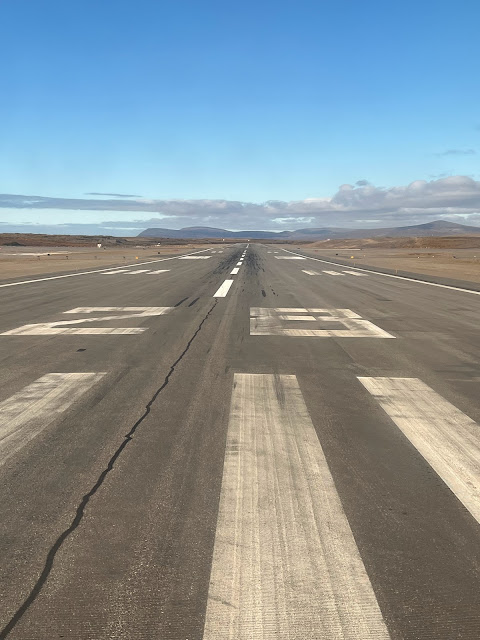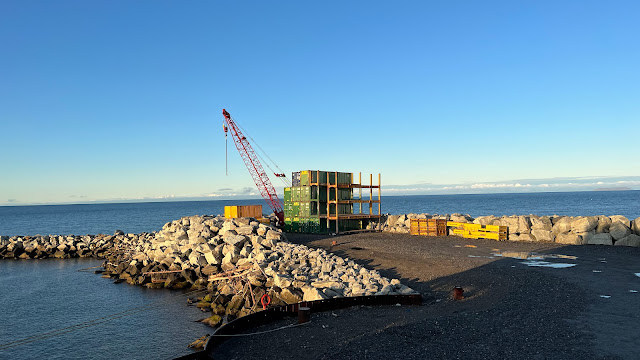Fresh off the boat this morning, we were driven around Nome in a couple of those gorgeous yellow US school buses - a pretty bumpy ride but a bit of fun. Somebody had spotted some musk ox so off we set - unsuccessfully.
 |
| And the wheels of the bus go ...... man it was a bumpy ride |
 |
| The Carrie M McLain Memorial Museum |
We visited Nome’s Carrie M McLain Memorial Museum which has a wonderful and thought-provoking collection dedicated to preserving the cultures and history of Nome and the Bering Strait people. The King Islanders (remember those derelict structures on the island?) who now mostly live in Nome had created a beautiful installation nestled against an
umiaq (skin boat). Come summer and open waters, they, and others from surrounding Bering Strait communities, would sail to the beaches of Nome to camp - up until the 1960s. While summering at Nome, families took on summer jobs, traded, gathered berries, and hunted for birds and fish. Back when King Island was inhabited, the Islanders would leave for Nome around June or July and head back in October. Each trip took around 14 hours nonstop in a skin boat. It is an excellent museum but we/I didn't have enough time to explore - they had to tip a few of us out.
 |
| A necklace of crab jawbone |
 |
| Gold mining stuff |
 |
| The King Islanders installation - seal skin foreground, Umiaq background. |
The King Islanders' display was excellent and very well documented. An
umiaq (skin boat) consists of a light driftwood frame over which a Bearded Seal or Walrus hide cover was stretched. Traditional skin boats ranged from 20-50 feet in length and were measured by the number of skins required to cover the sides. An inflated sealskin float could be lashed to the bow for stability. They could be propelled by the current, dogs on the shore attached with lines, paddles, oars, or sails. So inventive.
 |
| A huge variety of housing styles |
 |
| Dogs that participate in the Iditarod race. |
After the museum we were taken to meet some sled dogs. These dogs live to run and participate in the Iditarod race which is world famous amongst dog people of the north. It is a sled-dog race and evidently the Alaskan Huskies are the best. The length of the race, 1049 miles, is symbolic of Alaska becoming the 49th state. People come from around the world with their dogs and also to just be involved. These dogs seem to live to race.
 |
| Nome and the gold rush |
 |
| This guy gave us a go at panning for gold - great tourist 'thing' |
 |
| Lindsay having a go. |
 |
I didn’t come up with gold but beautiful garnet ‘sand’
which glowed in the sun (the red stuff!) |
 |
| Gold 'flour' |
From dogs to gold which put Alaska on the map. We were taken to a prospectors 'camp' and were shown how to pan for gold. I don't think any of us found any. The prospector showed us some gold ‘flour’ which he had found in beach sand collected along the 25 odd miles of beach. He then melts it down. There also a bit of silver amongst the gold.
 |
| Great repurposing - the Community Centre |
The local community put on lunch for us after we had met the sled dogs and done some gold panning. Gold is still a big thing up here - some of that involves ‘sifting’ through sands along the beaches and sea floor. It washes down in the rivers. And of course we took a turn around the local trading store to check goods and prices - interesting.
 |
| Interesting checking out what's on offer (and remember these are US$ and lbs not kg |
Then we piled into local buses and were ferried out to the airport for the slow wait BUT eventually we were off away from the wilderness and flying over the coast southeast to Anchorage.









































